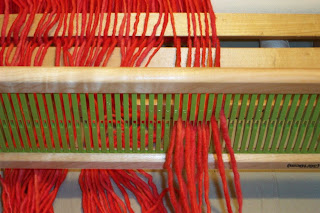I am always looking for new ways to do things that will either allow me to do what's necessary in less time, or cause the least amount of angst whilst doing it.
While whining to a friend this morning about that pesky linen, which was causing me the most grief not in the weaving but in the winding of the bobbins, the proverbial light came on over my head.
My doubling stand is set up so that the two yarns come up out of a two stage bucket and run over an S hook that dangles from a hook in the ceiling.
The linen is just springy and wire-y enough that if I wound too fast, or just because it wanted to be pesky, the linen would leap off the S hook. Sometimes just one, sometimes both, but either way it meant that the yarn broke, or the two threads got out of alignment. In the long run it meant that winding bobbins was becoming a bit of a teeth grinding time for me.
As I was describing the pesky behaviour, I thought how much better it would be if the yarn ran through a ring. No way the yarn could escape! Ah-ha, says I - I do believe that I have a one inch tack ring in my toolbox!

I did have a ring handy so I put it up on the hook....

....a close up so you can see how it looks....and voila! Well behaved - or at least well controlled - linen!
Now for the item of faith...
The other thing related to the tea towels that had been vaguely bothering me was beaming the 2/16 warps. Since I had never been taught how to do this but just kept working at it until I sort of got it figured out I wondered if there wasn't a still simpler and faster way than what I was doing.

On the last warp I thought to myself, why am I strumming and brushing this warp? Didn't I do a good enough job that it should just wind on? So I didn't, and it did, with just one thread that snagged and broke.
This time I thought, okay, let's try this again and see if it was just a fluke, but let's also try something a little bit different. So instead of keeping the lease sticks between the reed and the breast beam I moved them beyond the breast beam to between that and the valet.
There were several improvements noticed. For one thing I had a much longer area that could be wound on before anything needed to be adjusted/moved. The chains stayed much neater. There were very few snags or loose threads until the last two yards (11 meter long warp) at which point I took out the brush and quickly dealt with those.
In the end I figure I halved the beaming time and much less fussing.
Happy new year and lots of fibre finessing to everyone!










































